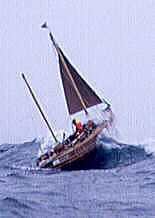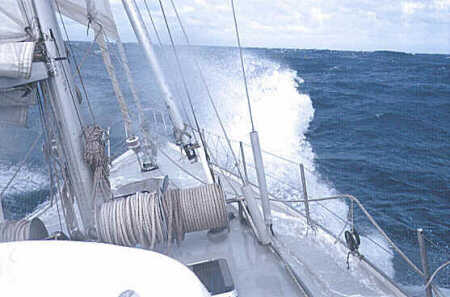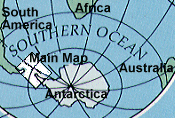
![]()
.
.
.

.
.
.
.
.
.
.
.
.
.
.
.
.
.
.
.
.
.
.
.
.
.
.
![]()

[
Logbook Index ]

Log
Entry for 28 January 1997
Pelagic to the Rescue.
|
Abandonment had been discussed in some detail while in Potters Cove. Although the crew of the Tom Crean were thinking positive, they all knew that if, say, a medical emergency arose with an individual, or they had some structural problem with the hull of the Crean, then abandonment was the only option. Therefore one of Pelagic's many roles as support vessel was to stand-by to effect a rescue. It was clear to me that a transfer of the crew from the Crean to Pelagic in a typical Southern Ocean swell would carry some risk and not be easy. Coming alongside would need flat calm conditions. A desperate leap in a rolling sea could cause injury or worse between two clashing hulls. We therefore planned two options depending on the conditions. In light to moderate conditions we would inflate our four meter dinghy without the floor and lower it back downwind on one of our towing warps. The Crean's crew would snatch the dinghy, pile aboard and then be reeled in. In our second scenario, when high winds and seas would make even inflating the dinghy on deck nigh impossible, we would resort to a more desperate affair of sending down a floating line with a loop. They would then attach themselves one by one to the loop with their harnesses, jump overboard in their survival suits, and be reeled in by Pelagics winches to be landed like tuna in the stern scoop. This latter option would only take place if the Crean was literally sinking from under them. There is an old adage that says "never take to the liferaft while your ship is underneath you!" When the call was made to hook them off, there was little preparation to do on our side. We decided to delay until first light the next day in the hope of the wind abating. It did to some extent, but by 0400 it was still blowing 25 knots and the sea, although not breaking, was still big enough to make rigging the dinghy on the foredeck hard work. Our plan was to take them in tow upwind, using one of our four 22mm polypropelyne floating lines that we carry on spools on the mid-deck. Each is 120 meters in length and are principally used as warps to tie to shore. Because they float they are ideal for a tow line. The last thing we needed was a line around the propeller due to the rope going slack in the swell ! We took a few passes close in to size up the situation, then casually tossed an end over to the Crean which was made fast to their bow. We let out about 40 meters of line, but this was still snatching violently in the swell . The next task was to get the dinghy over the side and fastened to another floating line. We also tied on a bucket as a bailer, in case they got swamped. We paid out the dinghy just enough so it was astern of the Crean, then I motored in a tight circle to draw the dinghy within their reach. We had considered sending the dinghy down the towrope, but decided against this in case it fouled itself and got stuck half way. They piled in their gear and then two bodies followed. It was a simple case of winching them in. Then two more, but just as Jarlath was about to jump in, the dinghy got shunted away from the Crean by a wave. As a result, we decided to bring the second two in and make a third load. It was as if Jarlath, the builder of the Crean and the last to leave, was contemplating going down with his ship, as tradition calls for in the captain. He had just drilled several holes in the bilges to sink the Tom Crean. An abandoned vessel is a hazard to navigation so sinking her was a necessary but sad protocol. As she took on water, we didn't linger to see her ultimate demise, but high tailed it northeast towards South Georgia exploiting the break in the weather. 
High tailing it to South Georgia The interior of Pelagic was soon festooned with five sets of Musto's three layer foul weather gear system and other pieces of wet clothing. At lunch, their first at a table for eight days, the crew were of the opinion that if Shackleton in the James Caird had that strength of a gale they probably wouldn't have made it either - but then again they were different men in different circumstances and as we know Shackleton 'was lucky.' That night, as we reached along at eight knots towards South Georgia, a great wandering albatross carved long elipses around Pelagic. Was the spirit of the Tom Crean following in our wake? Skip Novak |
